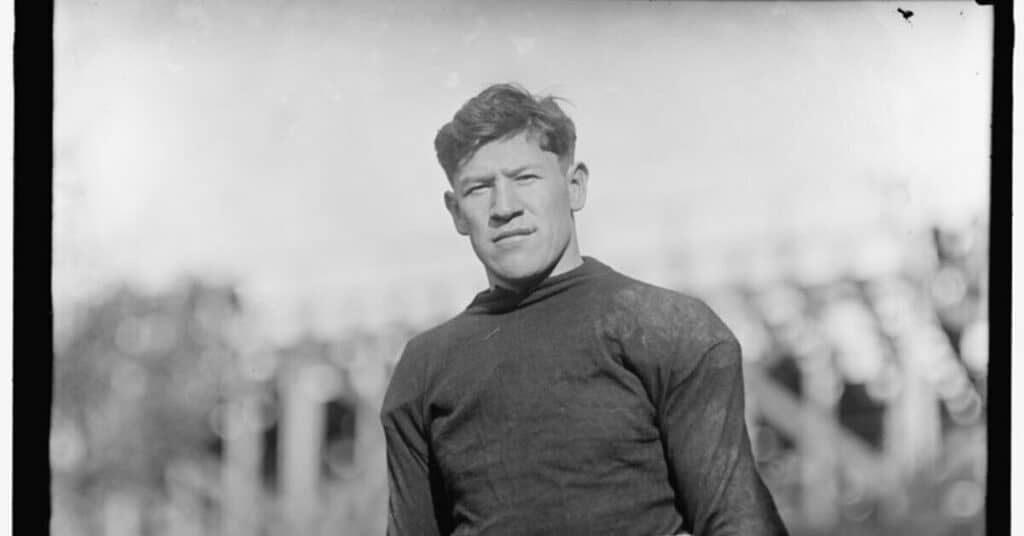
Have you heard the story of Jim Thorpe?
Not only was he the first Native American to win gold at the Olympics, but he's easily one of the most athletic human beings in history. He didn't just dominate at the 1912 Olympics with minimal training, but he obliterated nearly every sport he tried. During his unbelievable career, he played professional football... and professional baseball... and professional basketball.
Jim Thorpe's story is the story of a man overcoming utterly impossible obstacles in such a way that it seemed almost easy. He had to overcome personal tragedy, unbelievable racism, sabotaging teammates, and the death of multiple family members - including his mother - when he was a child. But he still overcame.
In his legendary 1912 Olympic events, someone stole his shoes - so he simply found two mismatched shoes in the garbage. One was too big and one was too small. Oh, and he still won gold. And then set several records, which you'll learn about later in this essay. The man was essentially unstoppable.
Jim Thorpe is a personal hero of mine and, I believe, the greatest athlete to have ever lived.
Jim Thorpe was a legendary Native American athlete who dominated the 1912 Olympics, winning gold. He also played professional football, professional baseball, and professional basketball.
When you think of the greatest athletes of all time a few names likely come to mind. Michael Jordan, Muhammad Ali, Wayne Gretzky, and Babe Ruth are some of the world's most famous and skilled athletes and consistently land in the top five when listing out the greatest athletes ever.
Another name that frequents these lists is Jim Thorpe. While his name might not be recognizable to the average American anymore, he was once a household name across the country. I think it's time Thorpe made a comeback. If you want to remember people for their athletic accomplishments, then everyone should know his name and story.
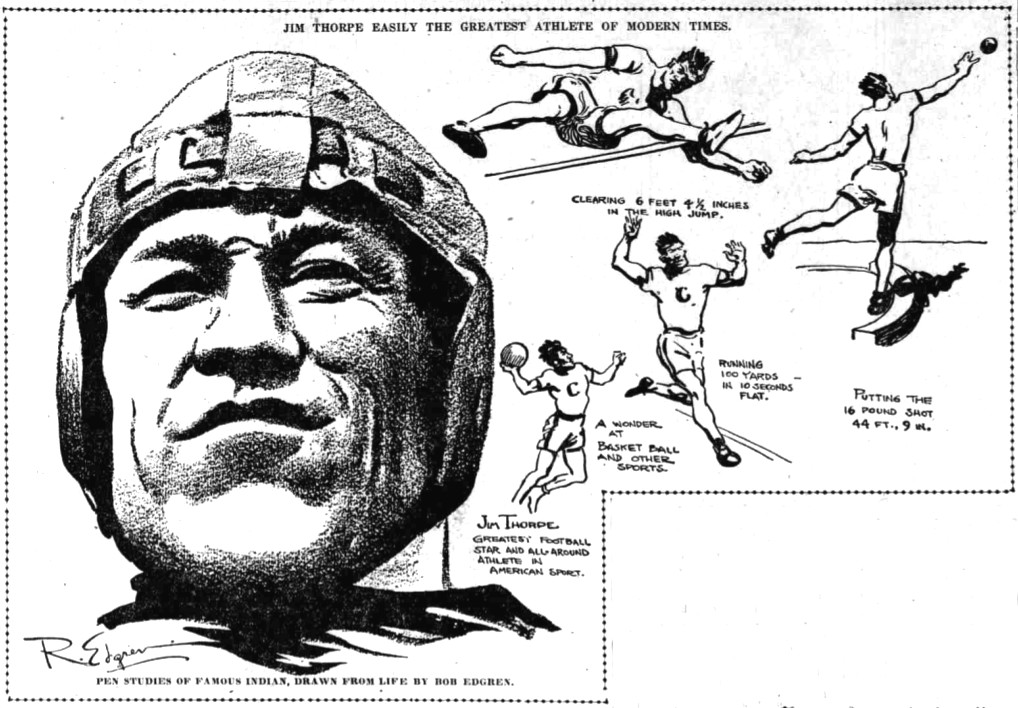
Unlike the other legends listed above, Thorpe didn't just excel in one particular sport. When you're talking about who the greatest multi-sport, all-around athlete is, most people would tell you that the answer is undoubtedly Jim Thorpe.
Sure, there are some other incredibly talented multi-sport athletes out there and men with remarkably versatile skills. Deoin Sanders, Carl Lewis, Wilt Chamberlain, and Jim Brown come to mind.
But Thorpe was in a league of his own.
He won the gold in the 1912 Olympic Games in both the pentathlon and the decathlon-- both of which are multi-event games that show his ridiculous versatility.
He didn't stop there, though. He played major league baseball for seven years, professional football for 13 years, and professional basketball for at least two years.
It's really difficult to say which sport Thorpe is best known for.
He was an All-Pro back as a professional football player. He kept the Olympic record for his points total for two decades after winning eight of the fifteen individual events of the decathlon and pentathlon.
As a basketball player, Thorpe displayed his abilities barnstorming all over the country. While his baseball numbers weren't statistically outrageous, the fact that he was able to compete at the highest level of the game certainly says something.
Basically, Thorpe could play any sport he tried with ease. He is a true sports legend and an American icon.
If you've ever come across a social media post about Jim Thorpe, there's a good chance it was accompanied by this picture of the legend during the 1912 Olympic Games:
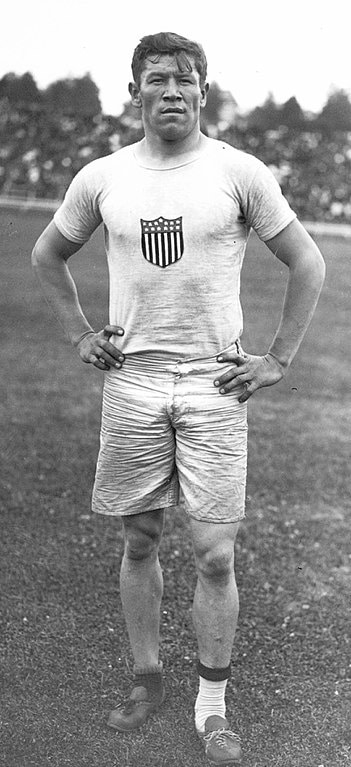
Why, you ask?
Look at his feet-- he's wearing two different shoes.
When this photo was taken, Thorpe had already crushed the field in the pentathlon, placing first in four of the five events. During the 1,500-meter run, he left his opponents in the dust, beating the man in second place by nearly five seconds.
The next week, it was time for him to compete in the decathlon which occurred over the course of three days.
In the pouring rain, Thorpe ran an 11.2-second 100-meter dash. No one was able to match that time at the Olympics until 1948.
Sometime after this event, just about the worst thing that can happen to a track and field athlete during the Olympics happened-- his shoes went missing.
Some accounts say that his shoes were missing on the second day of the decathlon. Others say that they disappeared a few minutes before the 1500-meter race portion of the decathlon was about to begin.
There are a lot of different theories about what exactly happened here-- who took Thorpe's shoes? Why were they missing? Had they been stolen?
Bob Wheeler, the author of the biography Jim Thorpe: The World's Greatest Athlete and the founder of the Jim Thorpe Foundation, believes that it was right before the 1500-meter race that his shoes went missing. He is a fairly credible source, considering that he conducted more than 200 interviews with teammates, friends, and family members of Jim Thorpe while writing his 1979 biography.
According to Wheeler, the story goes like this:
A few minutes between the decathlon's 1500-meter race, Thorpe's shoes were nowhere to be found. One of his teammates gave him one shoe to borrow. The second shoe? He found it in the garbage.
Not only was he wearing two mismatched shoes, but one of them was way too big for his foot and one of them was way too small.
The solution?
Thorpe squeezed his foot into the small shoe and wore extra socks on one of his feet to make the shoe fit better.
Most of us would whine and complain if we had to walk around in a too-big shoe and a too-small shoe for ten minutes at the grocery store.
Thorpe didn't just go out and compete against the world's greatest decathletes in the 1500 meters with mismatched shoes that didn't fit. He went out and won.
This is a timeless story that has a powerful message more than one hundred years later. It says never give up. Never quit. Never let obstacles stop you from attaining greatness.
Thorpe was the winner of the final event of the Olympic Games-- the 1500 meter (it's worth noting that Thorpe ran the 1500 meter twice during the Games, once for the pentathlon and once for the decathlon. He smoked the competition both times.)
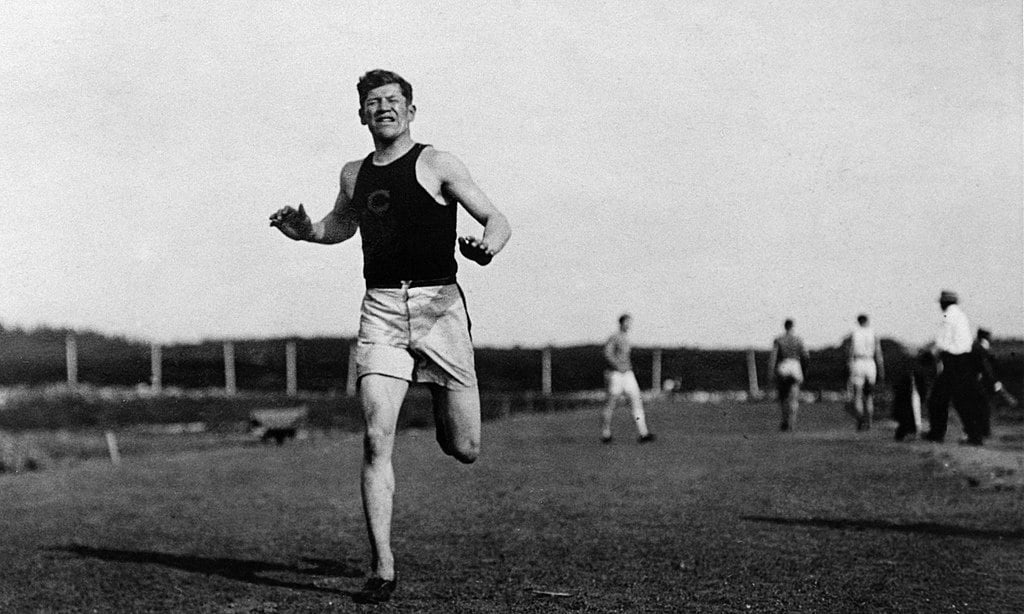
Each gold medalist was crowned with a laurel wreath as they came up to receive their medals by King Gustav of Sweden.
According to the New York Times, the crowd gave a "great burst of cheers led by the King" when Thorpe received his pentathlon gold.
For his decathlon performance, Thorpe wasn't just given his medal. He also received a bust of the king and a Viking ship-shaped jewel-encrusted chalice.
King Gustav of Sweden grabbed Thorpe's hand firmly and said, his voice shaking with emotion:
"Sir, you are the greatest athlete in the world."
What did Thorpe say in response?
"Thanks, King."
There is a lot we don’t know for certain about the beginning of Jim Thorpe’s life.
While it’s known that he was born in Indian Territory that would later be known as the state of Oklahoma, and he was baptized as “Jacobus Franciscus Thorpe” in the Catholic Church, no birth certificate was ever found for the American hero.
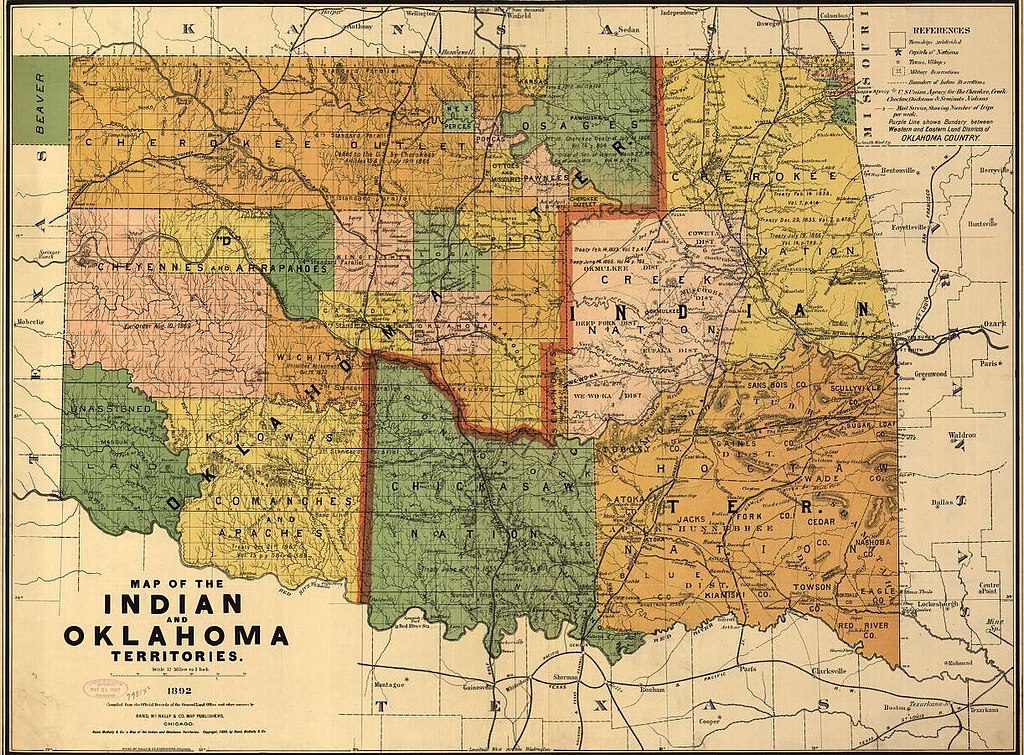
Most biographers believe that Thorpe was born near the town of Prague on May 22, 1887, which is the date that is listed on his baptismal certificate. However, Thorpe himself once said his birthday was May 28, 1888, in a note to The Shawnee News-Star in 1943. He also said that he was born:
“...Near and south of Bellemont– Pottawatomie County– along the banks of the North Fork River… hope this will clear up inquiries to my birthplace.”
Jim Thorpe grew up fishing, hunting, and learning from elders in what is now central Oklahoma, but what was, at the time, Sac and Fox land. He also played sports growing up, with baseball being an early favorite.
Both the parents of Jim Thorpe were of mixed-race ancestry. Hiram Thorpe, his father, was born to a Sac and Fox Indian mother and an Irish father. Charlotte Vieux, his mother, was born to a Potawatomi mother (descended from Chief Louis Vieux) and a French father.
According to popular legend, Jim Thorpe is a descendant of the infamous warrior Chief Black Hawk.
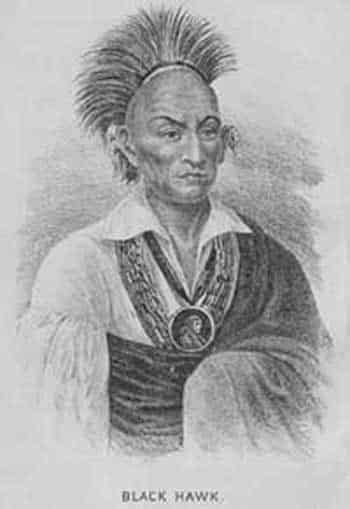
The autobiography of Black Hawk, entitled Autobiography of Ma-Ka-Tai-Me-She-Kia-Kiak, or Black Hawk, Embracing the Traditions of his Nation, was the first Native American autobiography that was published in the United States.
“I am no more proud of my career as an athlete than I am of the fact that I am a direct descendant of that noble warrior [Chief Black Hawk].” – Jim Thorpe
The native name of Jim Thorpe was Wa-Tho-Huk, which can be translated to mean “path lit by great flash of lightning,” or, more succinctly, “Bright Path.”
Raised as a Sac and Fox Indian, Thorpe’s native name comes from the fact that the path that led to the cabin where he was born was brightened by lightening around the time of his birth. This was custom for the Sac and Fox, who named their people something that happened near birth time.
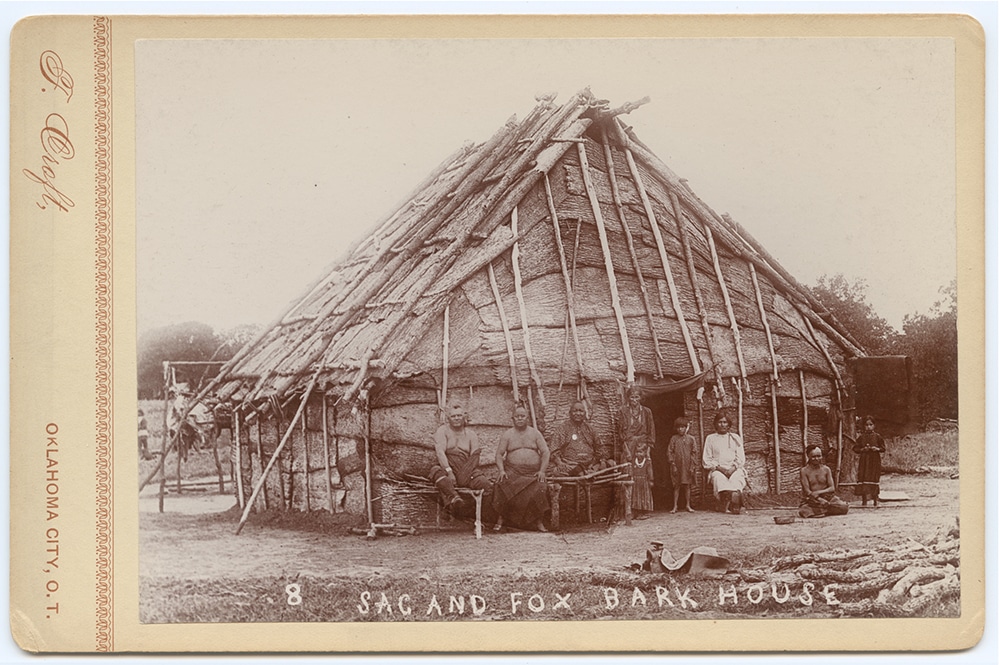
Thorpe had a twin brother named Charlie, and the two of them attended the Sac and Fox Indian Agency school in Stroud. Sadly, Charlie died of pneumonia when the boys were nine.
It is known that Thorpe ran away from the school he attended a number of times. Eventually, he was sent to an Indian boarding school (the Haskell Institute in Lawrence, Kansas) by his father. The reason he was sent away? So he would stop running away.
His life was struck by tragedy again when his mother died of complications during childbirth just two years after Thorpe was sent to the Haskell Institute. Understandably, he was left deeply depressed by the death of his mother. After getting into fight after fight with his father, Thorpe decided to leave home in order to work on a horse ranch.
When Thorpe was about sixteen in 1904, he went back to see his father again. He decided to go to the flagship Indian boarding school in the U.S. during the time– Carlisle Indian Industrial School in Carlisle, Pennsylvania. This school was founded in 1879 with the purpose of training Indians for hands-on trades and assimilating them into mainstream culture.
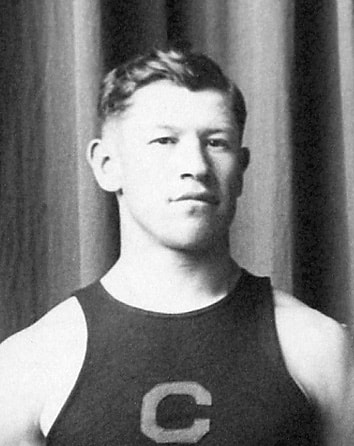
It was during this time that Thorpe’s incredible athletic ability was first recognized.
He was coached by one of the most influential coaches of early American football– Glenn Scobey “Pop” Warner.
Soon thereafter, Thorpe’s father died from gangrene poisoning after a hunting accident. This left the young man an orphan, and he dropped out of school once again. Before later returning to the Carlisle School, Thorpe spent another few years working on farms.
In 1907, In his third year at the school, Thorpe wandered by track and field practice and easily cleared a 5’9” high jump bar wearing his heavy overalls. In his plain street clothes, he beat all of the school’s high jumpers.
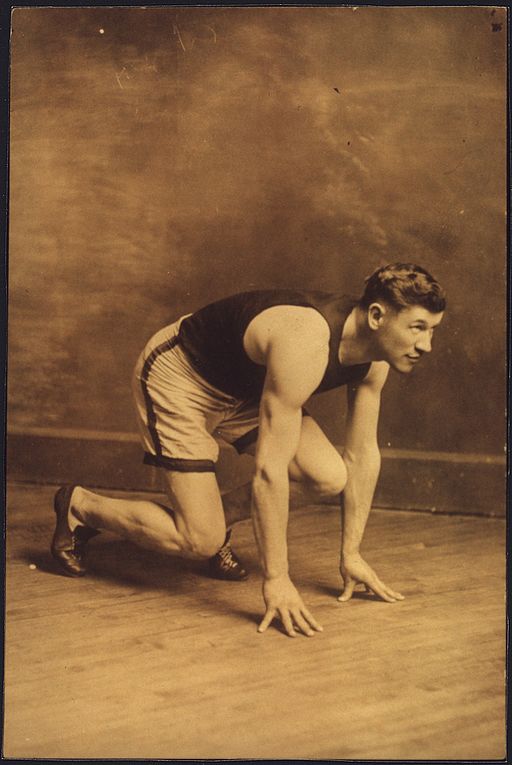
He didn’t just impress people with his athletic abilities in track and field, though. During this time, he also competed in:
That's right– ballroom dancing. In fact, he won the 1912 intercollegiate ballroom dancing championship.
Though Pop Warner was reluctant to let his best track and field athlete play the intensely physical sport of football, Thorpe convinced him to let him attend practice and try some rushing plays against the school’s defensive team.
Warner permitted this, figuring that Thorpe would quickly give up the idea after being tackled easily.
Of course, that never happened. Instead, Thorpe “ran around past and through them not once, but twice.” After his impressive display, Thorpe flipped Warner the football while saying that “Nobody is going to tackle Jim.”
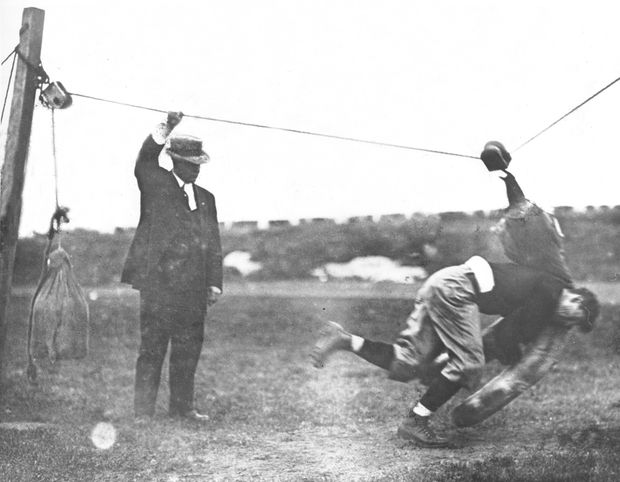
It was in 1911 that the American people started to notice Thorpe’s tremendous athletic ability. In a game against Harvard, a top-ranked team at the time, Thorpe scored all four of the field goals in the 18-15 upset. Amazingly, his team completed this season with a record of 11-1.
Thanks to Thorpe, Carlisle won the national collegiate championship in 1912. During the season, he scored a whopping 198 points and scored 25 touchdowns. By some accounts, he was responsible for 224 points and 27 touchdowns during this time.
Jim Thorpe even played against future President Dwight D. Eisenhower during a 1912 game against the West Point Army team. While the 92-yard touchdown Thorpe made during the game was nullified due to a penalty against a teammate, Thorpe rushed for a 97-yard touchdown in the next play. During the game, Eisenhower injured his knee when attempting to tackle Thorpe.
Eisenhower spoke of Thorpe’s performance during this game in a 1961 speech, stating that:
“Here and there, there are some people who are supremely endowed. My memory goes back to Jim Thorpe. He never practiced in his life, and he could do anything better than any other football player I ever saw.” – Dwight D. Eisenhower
In 1908, Thorpe received third-team All-American football honors. After heading to North Carolina for a time to pitch for the Rocky Mount Railroaders, Thorpe was lured back to Carlisle by Pop Warner. In 1911 and 1912, he was named a first-team All-American.
Even though Thorpe would gain his greatest fame from track and field, he didn’t compete in the sport in 1910 or 1911. Despite his incredible skills in a number of athletic endeavors, football was Thorpe’s favorite sport to play.
Jim Thorpe started training for the Olympics in the spring of 1912. Initially, he focused on hurdles, shot-puts, and jumps. However, being so incredibly versatile and skilled as an athlete, he added in the javelin, pole vaulting, discus, 56 lb weight, and hammer.
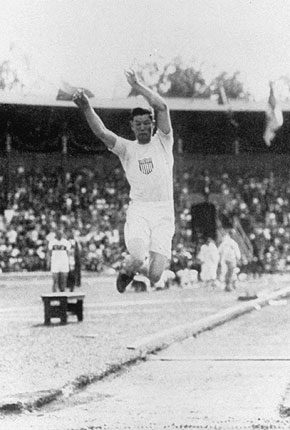
He earned himself a spot on the Olympic team thanks to his all-around ability during the Olympic trials held at Celtic Park in New York.
There were two new multi-event sports included in the 1912 Summer Olympics– the pentathlon and the decathlon.
The pentathlon was based on the event that had been a part of the Ancient Olympic Games, and consisted of:
The decathlon was also inspired by the pentathlon, but instead of consisting of five events, this one had ten. All the way back in 1884, there had been a ten-event competition known as the “all-around” or “all-round” championship which was quite similar to the modern decathlon.
The first appearance of the modern decathlon as a part of the Olympic Athletics program was at the Stockholm 1912 games– the games where Jim Thorpe displayed his superior athletic abilities.
The decathlon is split into two different days of events:
Since Thorpe was so versatile as an athlete (for example, he had gone to a number of track meets with Carlisle and served as a one-man team,), both of these new Olympic sports seemed the perfect fit for Thorpe.
After entering the trials for both events, Thorpe earned a place on the pentathlon team and was chosen to represent the U.S. in the decathlon.
You would think that competing in these two multi-sport events would be enough for most athletes. Thorpe, though, also competed in the high jump and the long jump at the 1912 games.
The first competition Thorpe competed in during the games was the pentathlon on July 7. Out of the five events, he won four. The fifth event– javelin– he had never competed in before that year and still placed third.
Thorpe won the gold medal and went on to qualify for the high jump final the same day. A few days later, he participated in the long jump and placed seventh.
The last event Thorpe participated in during those summer games was the decathlon. This was his first and only decathlon in his entire life.
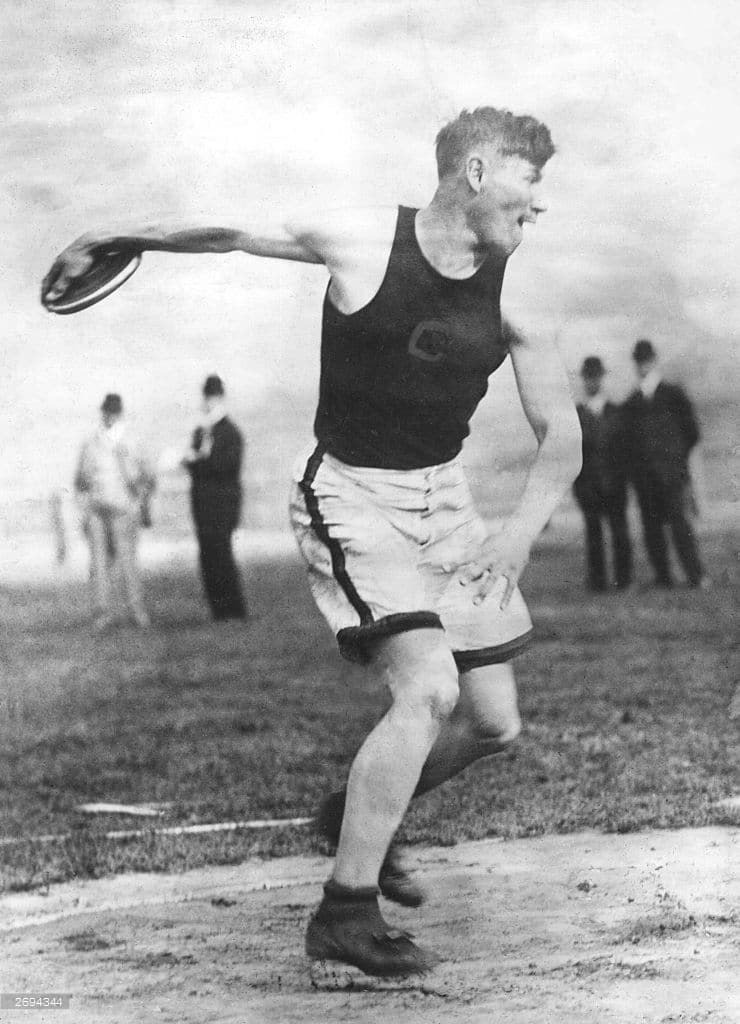
He went into the competition with some serious competition lined up. Everyone was expecting a strong performance by Hugo Wieslander, a Swedish athlete that had set the inaugural world record for the pentathlon the previous year.
He was no match for Thorpe in these games, though. Jim Thorpe defeated Wieslander in the decathlon by 688 points. Out of the ten events, Thorpe placed in the top four in every single one.
For nearly two decades, his Olympic record of 8,413 points stood strong.
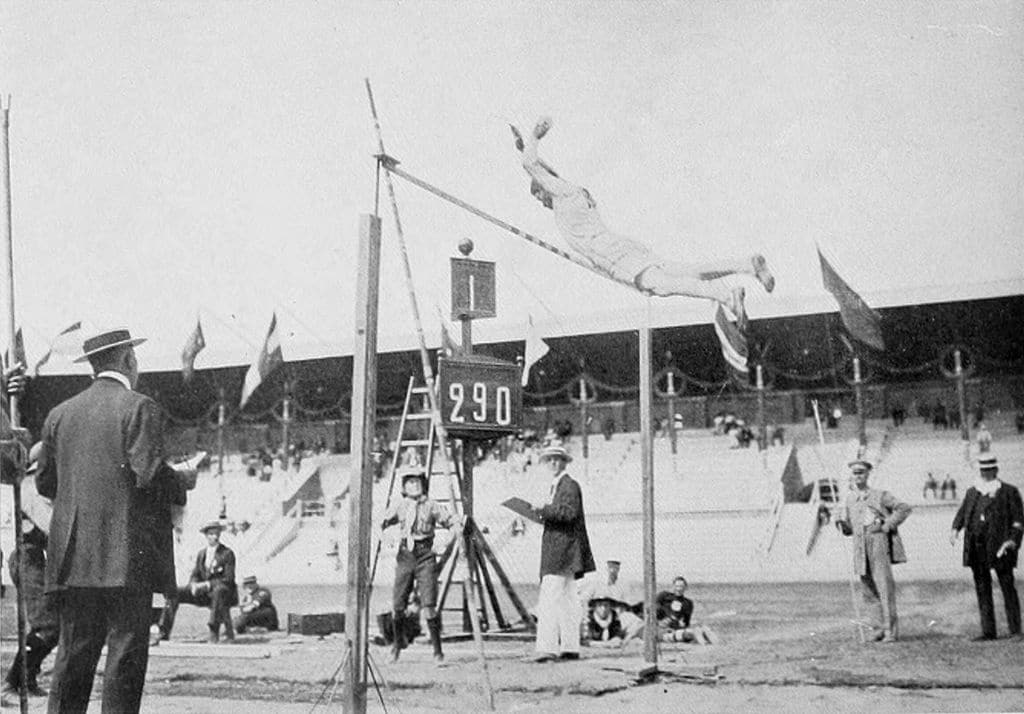
Out of the fifteen individual events that made up the decathlon and the pentathlon, Thorpe won eight.
All of this is remarkable on its own. To understand just how incredible his feats were during those games, you have to realize that someone had stolen his shoes just before he was due to compete.
While many athletes might be completely shot down by this occurrence, which their shoes being the most essential gear they have, Thorpe quickly found two replacement shoes. Not only were the shoes mismatched, but he fished one of them out of a trash can.
A true king, he put these ill-matched shoes on and won the gold medal.
The 1912 Summer Olympics also saw the sport of baseball for the first time in the history of the games. Included as a demonstration sport (meaning it was played to promote it rather than as a regular medal competition,) a game was played between the United States and Sweden.
The U.S. team was made up of various members of the track and field athletics delegation. One of the participating athletes was Jim Thorpe himself, who played in one of the two exhibition baseball games.
At the closing ceremonies of the games, Thorpe won two gold medals as well as two challenge prizes. These were donated by Czar Nicholas II of Russia for the pentathlon and King Gustav V of Sweden for the decathlon.
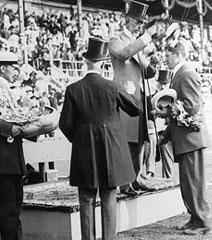
It is said that King Gustav commented to Thorpe when he was giving him his prize:
"You, sir, are the greatest athlete in the world"
Thorpe is believed to have simply said in return:
“Thanks, King.”
When Thorpe came home, he was given a hero’s welcome. At a ticker-tape parade on Broadway shortly thereafter, he was the star attraction.
After his domination at the Olympics, Thorpe went back to Celtic Park where he had qualified for the games several months earlier. There, he competed in the Amateur Athletic Union’s All-Around Championship.
Out of the ten events held, Thorpe won seven.
What happened in the other three? He came in second, of course.
During his performance, Thorpe broke the previously standing record of 7,385 points that had been set several years earlier in 1909 by achieving a total point score of 7,476.
The broken record had been held by Martin Sheridan, who was the Irish American Athletic Club’s champion athlete. Sheridan himself was no lightweight when it came to athletics, having won five Olympic gold medals.
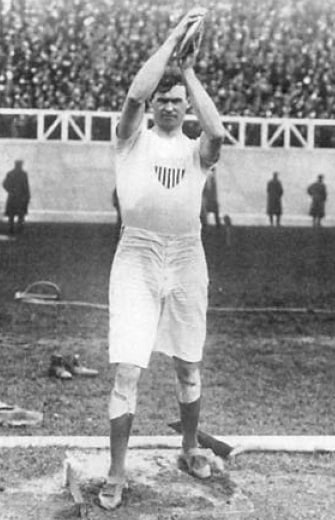
When Thorpe broke his record, he was there to watch it happen.
A good sport, he went up to Jim Thorpe after the event. As he reached out to shake his hand, he said:
"Jim, my boy, you're a great man. I never expect to look upon a finer athlete."
Sheridan went on to sing Thorpe’s praises to a New York World reporter, saying:
"Thorpe is the greatest athlete that ever lived. He has me beaten fifty ways. Even when I was in my prime, I could not do what he did today."
In 1912, athletes participating in the Olympics were held to strict rules about amateurism. At the time, athletes weren’t considered amateurs if they:
In order to compete in the Olympics, athletes had to be amateurs and not professionals by this definition.
Months after Thorpe’s domination of the games, in January 1913, it was reported that he had previously played professional baseball by the Worcester Telegram. The story was further circulated by newspapers around the country.
In 1909 and 1910, Thorpe received meager pay as a professional baseball player in the Eastern Carolina League. It is reported that he received somewhere between $2 and $35 per week, which, in today’s money, amounts to a range of $58 and $1,018.
The kicker was that college athletes regularly played professionally during the summers to help them earn some money. To sidestep rules against amateurism, most of these players used aliases. Thorpe, however, did not.
The American public didn’t care that Thorpe had briefly played professional baseball. He was an American hero. However, the case was taken very seriously by the Amateur Athletic Union. One of the founders and the secretary of the AAU, James E. Sullivan, was particularly concerned with Thorpe’s previous stint playing professional baseball.
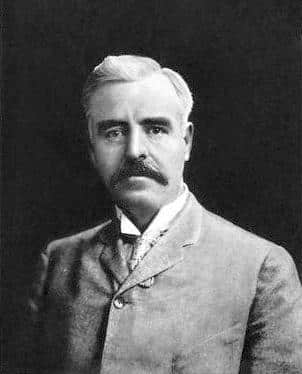
Thorpe wrote a letter to Sullivan to help explain that, while he had played pro baseball, he didn’t know he was doing anything wrong. In fact, he was just following the example of other college athletes.
“I hope I will be partly excused by the fact that I was simply an Indian schoolboy and did not know all about such things. In fact, I did not know that I was doing wrong, because I was doing what I knew several other college men had done, except that they did not use their own names …”
This honest admission, unfortunately, didn’t help his case. Thorpe’s amateur status was retroactively withdrawn, and the International Olympic Committee stripped him of the titles, medals, and awards he had won in the Olympics.
To further complicate the controversy, both the AAU and IOC had broken their own rules in disqualifying Thorpe. Protests had to be made “within 30 days from the closing ceremonies of the games” according to the 1912 Olympics rule book, but the first reports of the issues didn’t pop up until six months after the conclusion of the games.
Beyond that, there’s even some evidence that Thorpe’s time playing pro baseball was known to the AAU before he competed in the Olympics. Only when confronted with this fact did they decide it was a meaningful issue.
It wasn’t until three decades after his death that his status as an amateur was restored in 1982 and his family was presented with two medals in a ceremony.
However, the battle to correct the record wasn’t over.
Even though the IOC had restored his status as an amateur and returned the medals to his family, they didn’t declassify the other medalists from the 1912 games. This means that he was still essentially considered a co-winner, rather than rightfully restored as the sole winner.
Believe it or not, it wasn’t until July 2022, 110 years after the Olympic Games in Sweden, that the IOC announced that Thorpe would be reinstated as the sole Olympic champion in both the pentathlon and the decathlon.
Being stripped of his medals was devastating to Jim Thorpe. The only positive outcome of the whole ridiculous endeavor was that he started receiving offers from professional sports clubs as soon as it was reported that he had been declared a professional.
Thorpe was a free agent at the major league level after the Olympics because his contract had disbanded in 1910 with the minor league team that he had last played for. This was highly unusual for the time because this was during the era of the reserve clause in North American professional sports. This meant that pro athletes rarely had the opportunity to change teams unless they were given an unconditional release.

This meant that Jim Thorpe had his pick of the litter when it came to which team to play for.
Turning down an offer with the St. Louis Browns, he decided to join the New York Giants. The Giants had been the National League champions the previous year.
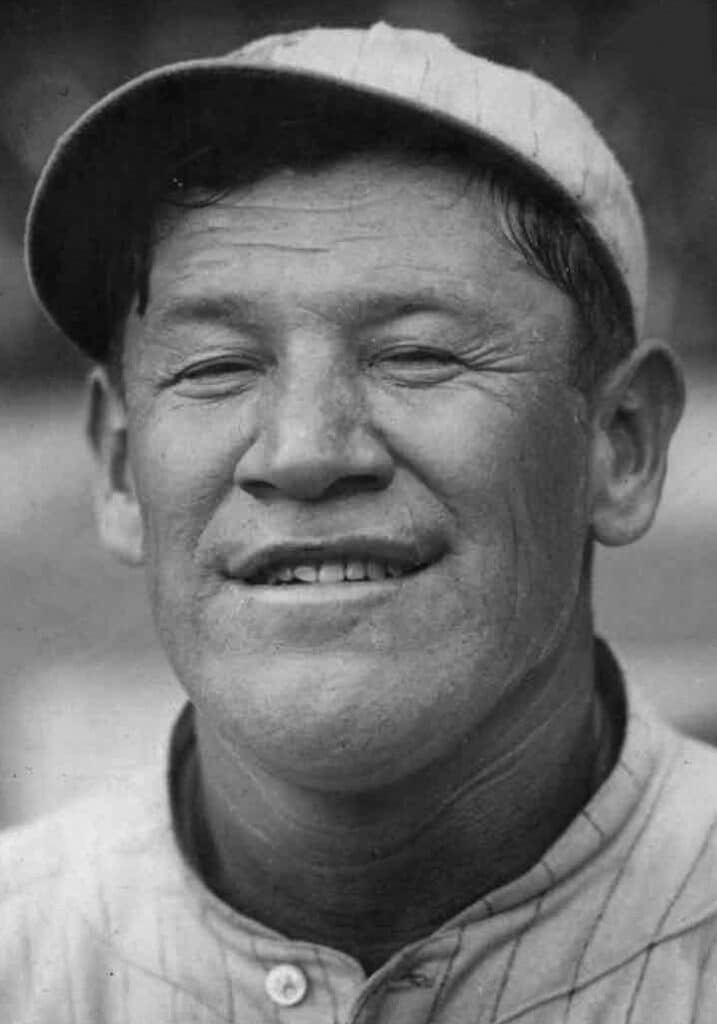
With the help of Thorpe’s superior athletic abilities, the Giants once again became the National League champions in 1913.
Shortly after the Giants lost the World Series, they embarked on a world tour with the Chicago White Sox. Unquestionably, the celebrity on the tour was Jim Thorpe.
On this incredible journey around the country and the world, Thorpe was able to meet major world figures including Pope Pius X and Abbas II Hilmi Bey. He even played to a huge crowd in London that included King George V.
Thorpe continued to play sporadically for the Giants. He had a short stint with the Milwaukee Brewers (a minor league team) before returning to the Giants and then being sold to the Cincinnati Reds.
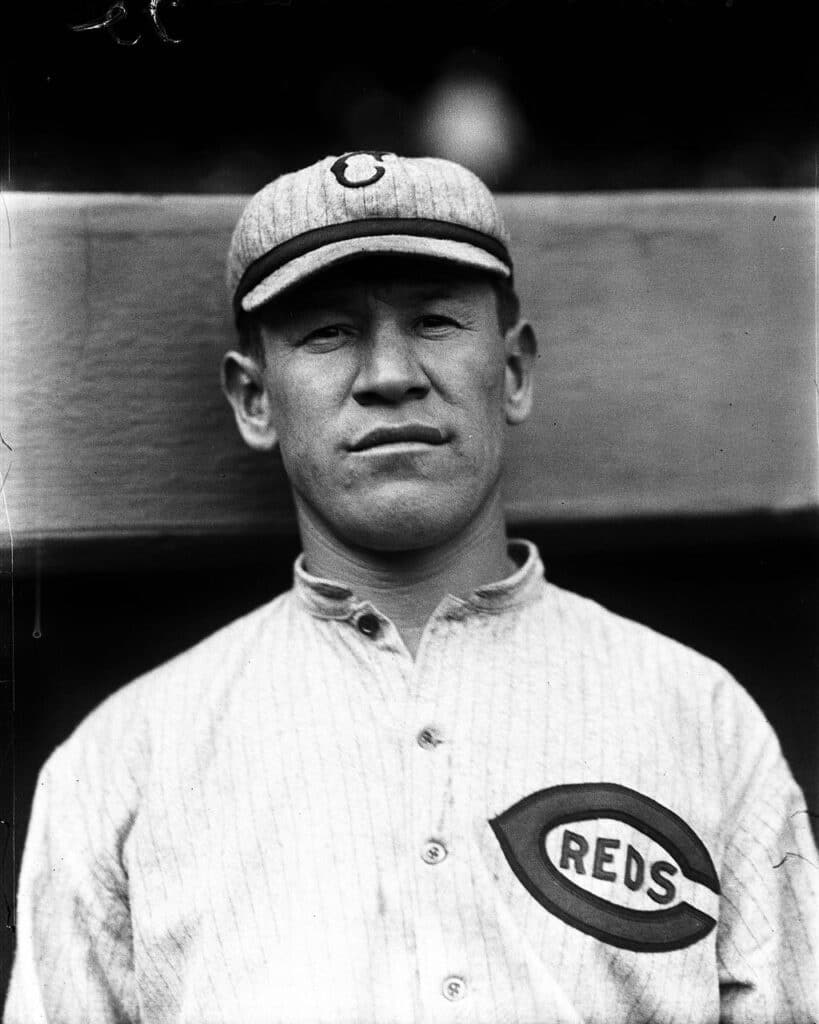
His team-hopping didn’t end there– he went back to the Giants before being traded to the Boston Braves in 1919.
Until 1922, Thorpe continued to play minor league baseball.
While it sounds like Thorpe was pretty busy playing baseball after the Olympics, he hadn’t abandoned his love of football. He played with the Pine Village Pros in 1913 and then with the Canton Bulldogs in 1915.
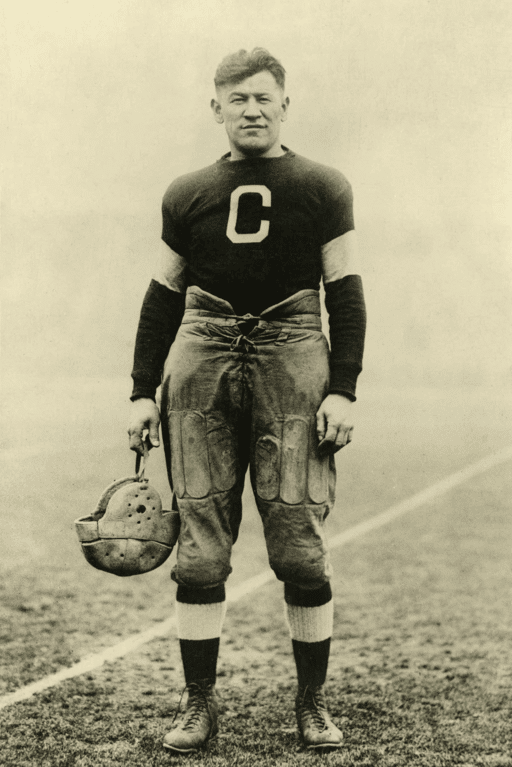
The Bulldogs certainly recognized the worth of this incredible athlete. Reportedly, Thorpe was paid $250 per game, which amounts to nearly $6,700 in today’s dollars. At the time, this was a truly incredible wage.
The team got their money's worth, too. Before Thorpe joined the team, about 1,200 would attend their games. For Thorpe’s debut game, 8,000 fans showed up– more than six times more than the average attendance.
Thorpe played for the Bulldogs for a number of years. In one particularly legendary championship game in 1919, Thorpe put the game out of reach to the competition by kicking a (wind assisted) 95-yard punt from the 5-yard line of his own team.
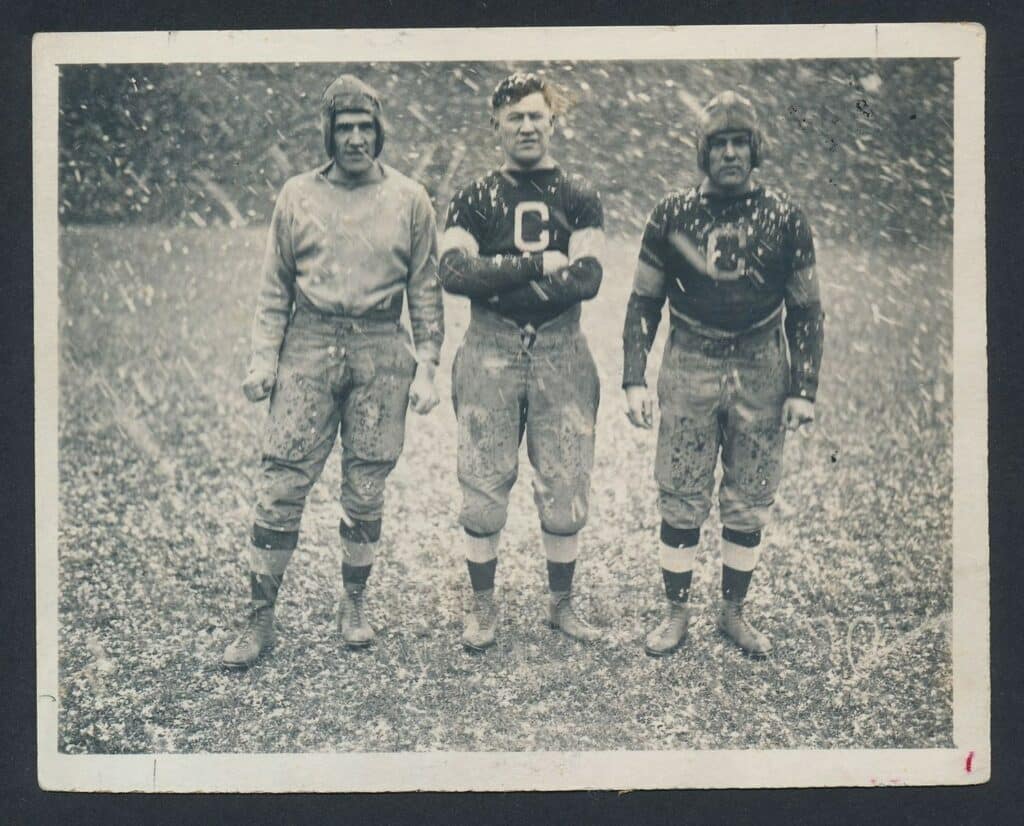
The Bulldogs were one of fourteen teams to form the American Professional Football Association in 1920– the organization that would become the NFL in just two years.
Who did they select as the inaugural president of the APFA? Why, Jim Thorpe, of course.
True to his nature, though, Thorpe just spent most of the year playing football for Canton. His tenure as the president of APFA only lasted until 1921.
Between 1921 and 1923, Thorpe helped to organize and played for an all-Native American team, the Oorang Indians.
Even though the team didn’t do that well, Thorpe’s incredible skills during the seasons were recognized. He was selected for the first All-NFL team in 1923, which later was recognized formally to be the league’s official All-NFL team.
After having played football for six different teams between 1920 and 1928 and playing in 52 games, Jim Thorpe retired from professional football at the age of 41.
Believe it or not, Jim Thorpe also had a basketball career that was unknown even to his biographers until 2005. How did they find out about his stint as a pro basketball player? From a ticket was found in an old book.

Thorpe played on a traveling basketball team as the primary feature of the “World Famous Indians” of LaRue. For at least two years, he barnstormed with the team in a number of states.
At this point, you must be thinking that we’ve reached the end of Thorpe’s athletic versatility. After all, he dominated in track and field while also playing professional baseball and football all while he was still a young man.
Believe it or not, though, Thorpe also considered going into professional hockey for the Tecumseh Hockey Club in Canada for a brief time in 1913. Imagine being so athletically talented that you could choose to play just about any sport at the pro level!
Over the course of his life, Thorpe married three times and was the father of eight children.
His first marriage was to Iva M. Miller in 1913, who he met at Carlisle Indian Industrial School. Between 1917 and 1923, the couple lived in a home in Yale, Oklahoma that is now known as the Jim Thorpe House.
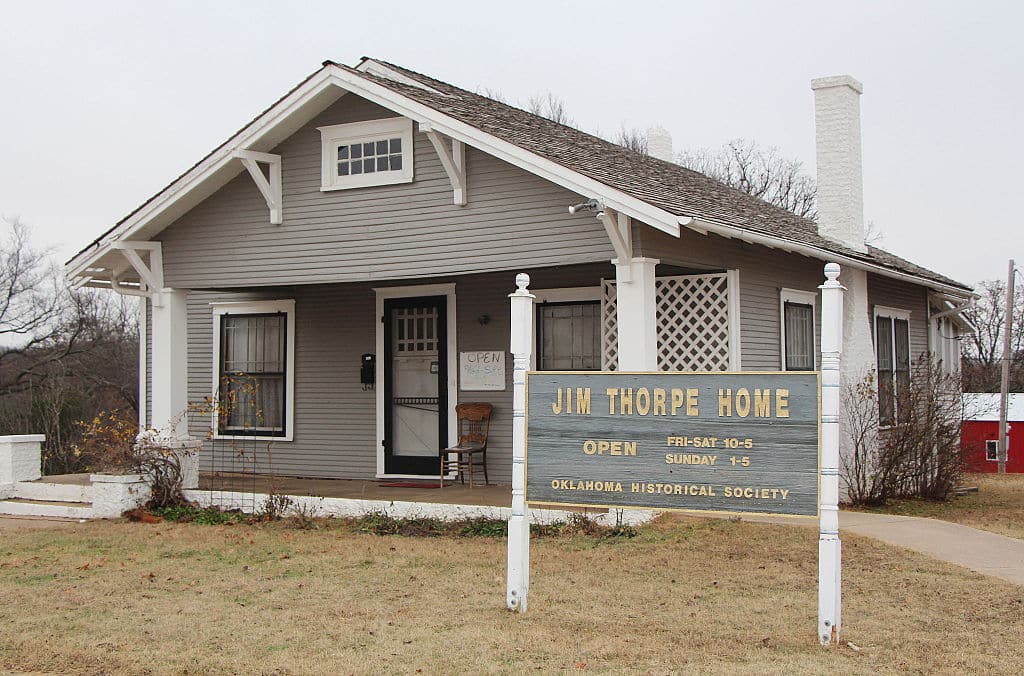
Together, they had four children:
In 1925, Iva filed for divorce on the grounds of desertion.
A year later, Thorpe married for the second time to Freeda Verona Kirkpatrick, who was working for the manager of the baseball team Thorpe was playing on. Together, they had four children:
After fifteen years of marriage, in 1941, Freeda filed for divorce.
Four years later, Thorpe would marry the woman that he spent the rest of his life with. On June 2, 1945, he married Patricia Gladys Askew.
It is unclear how many descendants there are living of Jim Thorpe's. One grandson, Michael D. Koehler of Chicago, was a football star himself in his youth. He went on to be an educator and coach before passing away in 2015. Several of his grandsons were present to receive the AAU Gussie Crawford Lifetime Achievement Award for their grandfather, and a number of grandchildren have been outspoken about their opinions regarding the campaign to reinstate Jim Thorpe’s place as the sole winner of the decathlon and the pentathlon during the 1912 Olympic games.
Once his athletic career had come to a close, Thorpe struggled working jobs that weren’t related to sports. He found it difficult to provide for his family and never stayed with the same job for very long.
He had worked a ton of different jobs during the Great Depression, including as an extra in a number of movies. In most cases, he was cast in Westerns as an American Indian chief.
Thorpe was cast as himself in a 1932 comedy Always Kickin’, where he played a coach that was instructing young players how to drop-kick.
While the Great Depression was still going strong, Thorpe sold the film rights to his life story for $1,500, which is about $27,000 in today’s money.
In 1940 and 1950, Thorpe was in the films Knute Rockne, All American, and Wagon Master, respectively.
In 1951, the truly legendary athletic career of Jim Thorpe was memorialized in the film Jim Thorpe- All American. There had been a number of rumors that Thorpe didn’t get any money for the film, but Warner Brothers did pay him $15,000 in addition to $2,500 that went towards an annuity for him.
In addition to working in films after his athletic career, Thorpe worked a bunch of different jobs, including:
During WWII, Thorpe even briefly joined the Merchant Marines.
In his later life, Thorpe sadly struggled with chronic alcoholism until his death in 1953.
The later years of Jim Thorpe were plagued with problems, including chronic alcoholism and money troubles. In 1950, he was admitted to a Philadelphia hospital as a “charity case” to treat lip cancer.
While dining with his wife in their Lomita, California home, Patricia, in early 1953, Thorpe went into heart failure for the third time. For a brief period of time, he was able to speak to the people around him after being revived by artificial respiration. Shortly thereafter, though, he lost consciousness and passed away. The world’s greatest athlete died at the age of 65.
Supporters of Thorpe fought for decades for his Olympic titles to be reinstated. Over the years, several attempts were rebuffed by US Olympic officials.
Those that stood between Thorpe and his rightful honors included Avery Brundage, who wasn’t just the president of the IOC but also Thorpe’s former teammate. He was quoted as having said, “ignorance is no excuse.”
The author Robert Wheeler and his wife, Florence Ridlon, were among Thorpe’s most persistent advocates. They established the Jim Thorpe Foundation in 1982 and were able to prove that Thorpe’s disqualification occurred after the time period allowed by the Olympics rules. Thanks to their hard work and the support they gained from the U.S. Congress, the IOC Executive Committee agreed to reinstate Thorpe’s medals.
However, the saga didn’t end there.
Instead of declaring him the sole winner of the events he won, the pentathlon and the decathlon, they announced him to be co-champion with Wieslander and Ferdinand Bie. This is particularly ridiculous considering that both of these athletes had always held that Thorpe was the only champion in their eyes.
Two of Thorpe’s children, Bill and Gale, were presented with commemorative medals in 1983 by the IOC. The original medals had sadly been stolen from museums and never recovered.
Recently, in July 2020, a petition started going around asking that the IOC declare Thorpe to be the sole winner.
Circulated by Bright Path Strong and backed by Pictureworks Entertainment, the IOC finally voted to make Thorpe the only winner of both the pentathlon and the decathlon on July 14, 2022.
Jim Thorpe is considered to be one of the best athletes of all time. During his life and posthumously, he has been the recipient of countless awards and honors.
Here’s just a small sampling:
According to Red Smith, a renowned sports writer:
"Thorpe was the greatest athlete of his time, maybe of any time in any land."
Let’s take a look at some of the organizations, events, and in one case, a town, that was named after the greatest athlete of all time.
Beginning in 2019, Jim Thorpe, Pennsylvania, started holding the Jim Thorpe Area Running Festival. A series of races are held during the event, including a 26.2-mile marathon.
Based in Oklahoma City, the Jim Thorpe Association is a charity and civic organization that is named in memory of the legendary Jim Thorpe. Since 1986, they have been awarding the Jim Thorpe Award to the top college football defensive back.
The Oklahoma Sports Hall of Fame is also a part of the Jim Thorpe Association. Every year, they induct at least two athletes based on their accomplishments.
When Jim Thorpe passed away, residents of his hometown had paid to have his body returned from California by train. His funeral was held in Shawnee, Oklahoma at St. Benedict’s Catholic Church. After the ceremony, his body lay in state at Fairview Cemetery.
The original plan was to build a memorial for the legend at the athletic park in Shawnee, and the residents started raising funds for this effort. State legislators were asked for funding by local officials, but the governor vetoed it.
All the while, Thorpe’s wife had his body shipped to Pennsylvania. The rest of his family had no idea this was happening.
She had heard that there were towns in Pennsylvania that were looking for ways to attract tourism and business. According to Jack, Thorpe’s son, she had made a deal with local officials for monetary benefit.
Essentially, the towns of Mauch Chunk and East Mauch Chunk bought the remains of Jim Thorpe.
At his grave, they built a monument to Jim Thorpe, merged the towns, and renamed the new town Jim Thorpe, Pennsylvania.
Jim Thorpe was buried in a town he had never once set foot in.
As you might imagine, this didn’t sit well with the rest of Thorpe’s family.
His son filed a lawsuit against the town in an effort to have his father’s remains re-interred near his family members in Oklahoma. After several years of complex legal happenings, the case was effectively brought to a close when the U.S. Supreme Court refused to hear it. Thorpe’s remains are therefore still in Jim Thorpe, Pennsylvania.
Though baseball wasn't Thorpe's best sport, the fact that he could compete at the professional level in so many different sports is truly remarkable. Over his major league baseball career, Thorpe amassed:
In his minor league baseball career, he had 7 home runs, a batting average of .252, and 176 hits.
Jim Thorpe played 52 professional football games and started 37 games. He played for 12 seasons professionally.
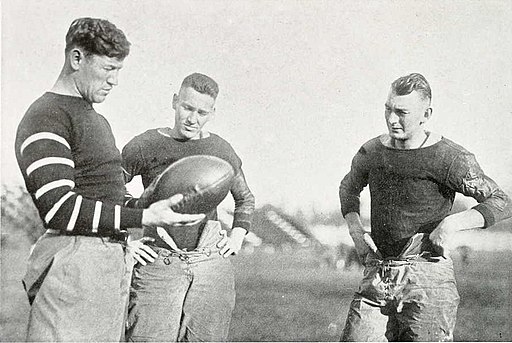
When he played for the Carlisle Indian School, he had 53 touchdowns in 44 games, scoring 421 points. He led the nation in 1912 with 29 touchdowns and 224 points.
Thorpe won gold in both the pentathlon and decathlon in the 1912 Olympic Games held in Stockholm, Sweden.
In his obituary in the New York Times, it was written that:
“He could run the 100-yard dash in 10 seconds flat, the 220 in 21.8, the 440 in 50.8, the 880 in 1:57, the mile in 4:35, the 120-yard high hurdles in 15 seconds and the 220-yard low hurdles in 24 seconds. He broad-jumped 23 feet 6 inches and high-jumped 6 feet 5 inches. He pole-vaulted 11 feet, threw a shot put 47 feet 9 inches, threw the javelin 163 feet, the hammer 140 feet and the discus 136 feet.”
Located in Jim Thorpe, Pennsylvania, there is a monument erected in the honor of Jim Thorpe at his gravesite. About 100 miles southwest of where he had attended Carlisle Indian Industrial School, the site of the monument contains his tomb, historical markers outlining his life story, and two statues of him posed in athletic positions.
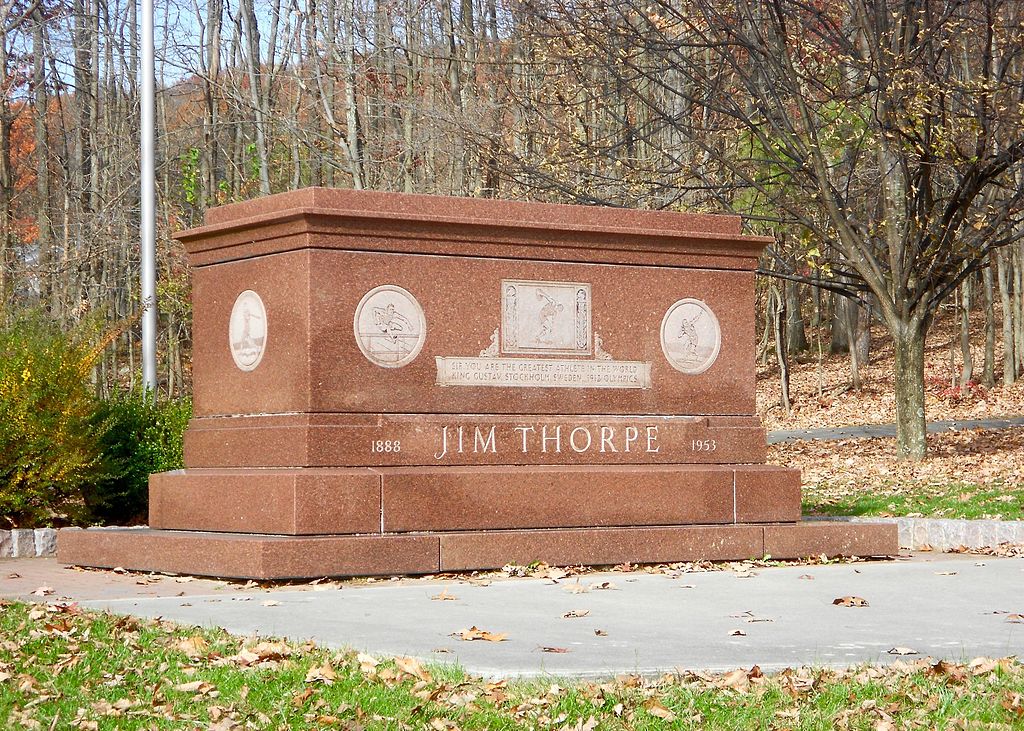
His grave rests on soil that had been brought from Thorpe’s native Oklahoma as well as from the stadium in Sweden where he won his Olympic medals.
Considering that Jim Thorpe was so incredibly talented and versatile as an athlete, and he is considered one of the greatest of all time if not the greatest of all time, it’s not a surprise that there is a memorial built around his grave.
What is surprising, though, is that it’s located in a place that he never once visited.
The short story is that Thorpe’s third wife was left in poverty after he passed, and she was frustrated by how long it was taking his hometown to raise the necessary funds to build a memorial.
So she took matters into her own hands and essentially sold his remains to two small towns in Pennsylvania that were looking for something to draw tourists.
The two towns united and were renamed Jim Thorpe, Pennsylvania, and his body still rests there under his monument, despite the efforts of his other family members to have his remains exhumed and relocated to his home state of Oklahoma.
The son of Jim Thorpe sued the town of Jim Thorpe in 2010 in an effort to have his father’s remains moved to Oklahoma. The suit was based on a 1990 law known as the Native American Graves Protection and Repatriation Act (NAGPRA). The law was designed to help rectify the historical plundering of Native American burial grounds.
While a federal district court agreed with him, the decision was reversed by the 3rd U.S. Circuit Court of Appeals in 2014.
When they tried to bring the case in front of the U.S. Supreme Court, they refused to hear it. For now, that’s where the story ends, and his body remains in Jim Thorpe, Pennsylvania.
Titled Man of Bronze in the UK, this film was produced by Warner Bros. in 1951 and was directed by Michael Curtiz. Thorpe was played by Burt Lancaster and the story was a biographical look at the life of the incredible athlete.
The film Bright Path: The Jim Thorpe Story, will be produced by Angelina Jolie and star Martin Sensmeier as the incredibly talented Thorpe. Jolie has stated that she has already spent time with Bill Thorpe and that she will be working with the Thope family and the Tribes will creating the film.
Partnering with Indian Country to create the film, the filmmakers say they are dedicated to telling the authentic story.
There’s a lot of excitement and hype around this film, but there’s no known release date as of yet.
If you're looking for a solid summary of the life and achievements of Jim Thorpe, this is a great source. Interviewing people knowledgeable about Thorpe and using old letters to substantiate the book's claims, this is a well-researched text about his life.
Some people consider this to be the definitive biography of Jim Thorpe. Highly detailed, this is a good book for individuals that are looking for a thoroughly-researched look at the entire life of the American icon.
This is another well-researched biography about the legend Jim Thorpe. Wheeler was a driving force behind Thorpe's medals being reinstated-- Sports Illustrated credits him with primary responsibility for his Olympic god medals being restored in 1982.
This narrative nonfiction book by Lars Anderson takes a look at one of the greatest contests in the history of college football. In a classic David vs. Goliath matchup that pits Jim Thorpe against future president Dwight D. Eisenhower, this is a tremendous story that will delight Jim Thorpe fans, football lovers, and American history buffs alike.
Over the years, a lot of books have been written about Jim Thorpe. Here are some other titles you might want to check out:
The story of Jim Thorpe is a wonderful way for children to learn about overcoming obstacles, the history of sports, and the difficulties faced by Native Americans in the early twentieth century.
Here are some of the books about Jim Thorpe written for children:
In short, Jim Thorpe was famous for being a truly incredible and versatile athlete. He is thought to have been one of the best athletes of all time, if not the best athlete of all time.
As the first Native American that won gold for the U.S. at the Olympics, he quickly became a national icon and hero. On top of dominating in track and field, Thorpe played baseball, football, and basketball.
Jim Thorpe competed on the American track and field team at the 1912 Olympics. He also played baseball, football, and basketball professionally. As an indication of his all-around athletic talent, he even briefly considered playing professional hockey.
Jim Thorpe didn’t just play for one team, he played for a huge handful of teams in several professional sports.
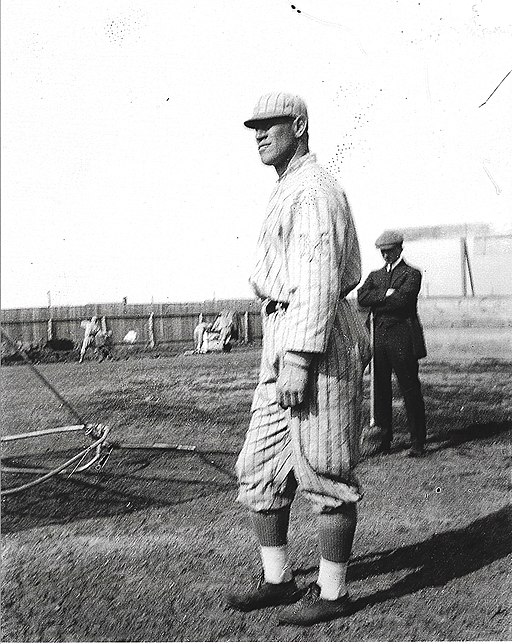
He played on:
Jim Thorpe was born in what is now Oklahoma near Prague, Indian Territory. At the time, the land was that of the Sac and Fox Nation.
Some accounts say Jim Thorpe was 5'11" while others call him 6'1". As you might imagine, his weight varied over the years, but it is said that he was 185 pounds when he competed in the Olympic games.
To help you get a picture of the man himself, during the Stockholm games he had a 42-inch chest, a 32-inch waist, and 24-inch thighs.
Jim Thorpe was a tribal member of the Sac and Fox Nation. Forcibly relocated to Oklahoma in the 1870s, this tribe was originally from the Lake Michigan and Lake Huron area.
There are two other Sac and Fox tribes, which are the Sac and Fox Nation of Missouri in Kansas and Nebraska and the Sac and Fox Tribe of the Mississippi in Iowa.
At the 1912 Olympic Games in Stockholm, Sweden, Jim Thorpe won the gold medal in both the pentathlon and the decathlon.
Jim Thorpe was stripped of his medals because the IOC and AAU were confronted with the fact that he had briefly been paid to play baseball. Based on the strict rules about amateurism at the time that barred professionals from competing in the Olympics, they took his medals away and removed his title as the winner of both the pentathlon and the decathlon.
Yes– but not until thirty years after his death. His medals were reinstated in the early 1980s. However, it wasn’t until 2022 that he was named the sole winner of the pentathlon and the decathlon rather than a co-winner.
The total points Thorpe won at the 1912 Olympics amounted to 8,412.95 out of a possible 10,000. This was 688 more points than the second-place finisher, Swede Hugo Wieslander. It would take four more Olympics for anyone to beat this score.
Of course, it's also notable that he was the first Native American to win an Olympic gold medal for the U.S.
When he played on Carlisle's football team, he ran 1,869 yards on 191 attempts, helping to lead the team to a 12-1-1 record.
Jim Thorpe didn't retire from professional sports until he was 41. In his later life, he appeared in a number of films, usually in Westerns as an American Indian.
He also worked a number of different jobs, including a security guard, doorman and bouncer, construction worker, and ditch digger.
Thorpe even had a brief stint in the Merchant Marines during WWII.
Unfortunately, he struggled with poverty and chronic alcoholism in his later life until his death in 1953.
In 1950, Thorpe was hospitalized for lip cancer. He also suffered from chronic alcoholism. Thorpe had three heart attacks in his life, the third of which was fatal. He passed away at his trailer home in Lomita, California on March 29, 1953.
While there are different stories about Jim Thorpe's mismatched shoes at the Olympics, the consensus is that he won a gold medal wearing two different shoes-- one too big and one too small.
According to Bob Wheeler, author of Jim Thorpe: The World's Greatest Athlete, Thorpe's shoes went missing just a couple of minutes before the decathlon's 1500-meter race.
Remarkably, this didn't shut Thorpe down.
He borrowed one shoe from a teammate and found the other in the garbage.
It's incredible in its own right that he forged forward with totally inadequate gear. He had to squeeze his foot into his teammate's shoe, and wear extra socks to make the shoe fit that he found in the trash.
To make the story even more insane, though, he still won the race.
Thorpe was an incredible being-- he was said to have "moved like a breeze" and with "a kind of ease in his gait that is hard to describe. Equilibrium with no strictures."
To me, Jim Thorpe was way bigger than sports. His is a story of facing tremendous obstacles and overcoming them. In American society, he became a symbol of the injustice that Native Americans faced.
He is the epitome of the notion that no matter what troubles you face in life, you can overcome them. Born without U.S. citizenship because he was raised as a Native American, Thorpe climbed his way up the ladder to become a tremendously famous American icon.
Though more than a century has passed since his Olympic victories, the story of Jim Thorpe is truly timeless.
This story is incredibly powerful to me, so I wanted to share it with you. Feel free to learn more about me and my projects here.
We encourage you to share this article on Twitter and Facebook. Just click those two links - you'll see why.
It's important to share the news to spread the truth. Most people won't.
